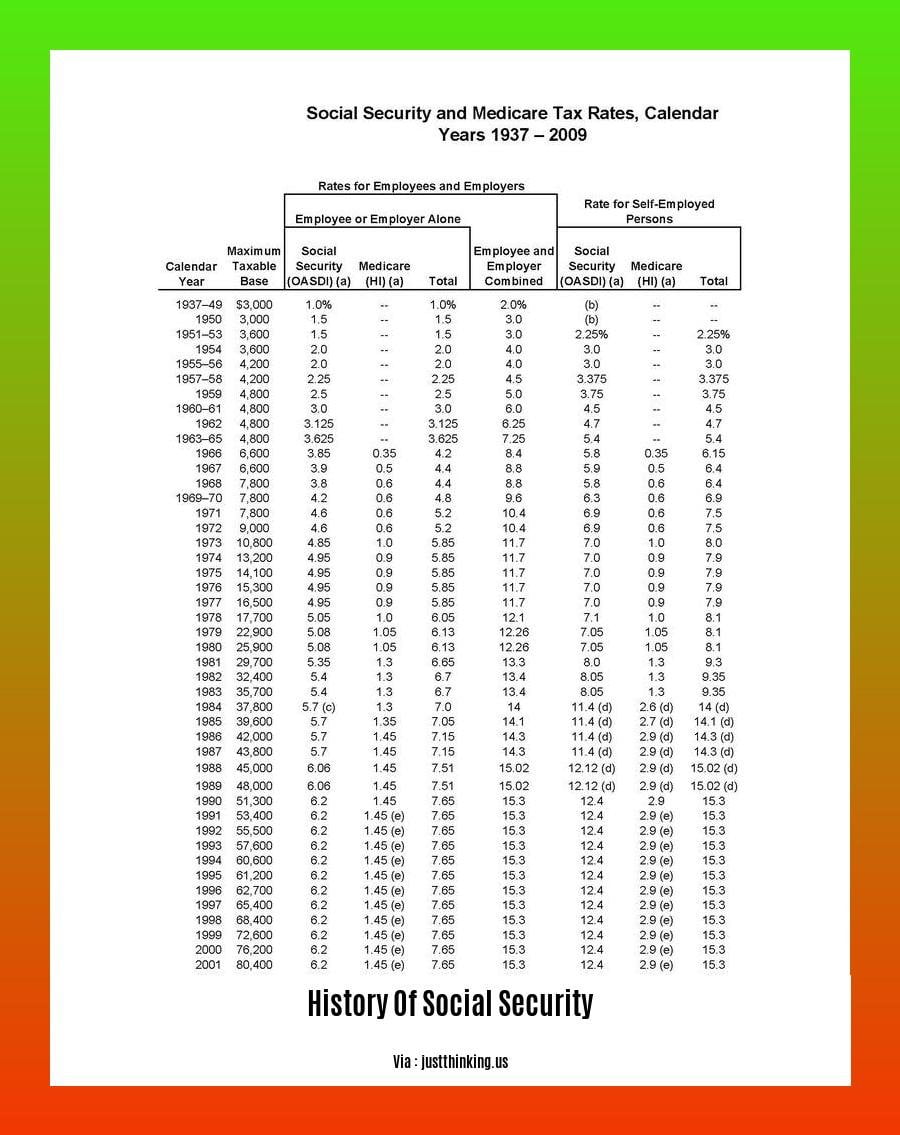Embark on a historical voyage through the evolution of social security, Roosevelt’s revolutionary concept that reshaped societal support systems. Discover the conceptual foundations and historical precedents that laid the groundwork for this transformative program, tracing its roots in America from early forms of social security to its profound impact on society. [- A Journey Through the History of Social Security: Unveiling Its Impact on Society] delves into the intricacies of this intricate safety net, shedding light on its enduring legacy.
Key Takeaways:
The Social Security program, established in 1935, provides financial support to retired workers.
Retirees over 65 receive benefits based on their lifetime payroll tax contributions.
Periodic adjustments are made to account for inflation and economic changes.
Retirement age and benefit amounts have been modified over time.
History of Social Security

In the depths of the Great Depression, President Franklin D. Roosevelt introduced a beacon of hope for the downtrodden masses: the Social Security Act of 1935. This revolutionary legislation, born out of the ashes of economic despair, marked a watershed moment in the annals of American history, forever altering the landscape of social welfare and shaping the lives of generations to come.
The Genesis of a Lifeline
The Social Security Act, crafted with meticulous care amidst the turmoil of the Great Depression, emerged as a lifeline for millions of Americans facing poverty, unemployment, and the looming specter of old age. The program’s architects, driven by a vision of a more just and equitable society, sought to provide a safety net for those whose livelihoods had been shattered by economic calamity.
Pillars of Support
The Social Security Act, in its initial iteration, rested upon three fundamental pillars:
Old-Age Benefits: A monthly stipend for retired workers over the age of 65, replacing the meager savings many had managed to accumulate during their working years.
Survivor Benefits: Financial assistance for spouses and dependent children of deceased workers, offering a lifeline of support during times of profound grief and economic hardship.
Unemployment Insurance: A temporary safety net for workers who had lost their jobs due to no fault of their own, providing a bridge over the tumultuous waters of joblessness.
The Evolving Landscape
Since its inception, the Social Security program has undergone a series of transformative changes, adapting to the shifting tides of economic and social landscapes.
Expanding Coverage: Over the years, the program’s reach has expanded to encompass a broader spectrum of individuals, including survivors of deceased workers, disabled individuals, and individuals with low incomes.
Adjusting Benefits: Recognizing the erosive effects of inflation, the program’s benefits have been periodically adjusted to maintain their real value and ensure that they continue to provide meaningful support.
Raising the Retirement Age: To ensure the program’s long-term sustainability, the retirement age has been gradually increased, reflecting changing demographics and life expectancies.
A Legacy of Impact
The impact of Social Security on American society has been nothing short of profound. It has:
Reduced Poverty: The program has been instrumental in slashing poverty rates among the elderly, providing a vital source of income for those who would otherwise be destitute.
Enhanced Economic Security: Social Security has provided a sense of economic security for millions of Americans, enabling them to retire with dignity and peace of mind.
Boosted Consumer Spending: The regular influx of Social Security benefits into the economy has played a significant role in stimulating consumer spending, contributing to overall economic growth.
The history of Social Security is a testament to the enduring power of human compassion and the government’s role in alleviating suffering and fostering a more just and equitable society. As we navigate the complexities of the 21st century, we must remain steadfast in our commitment to preserving and strengthening this vital program, ensuring that it continues to serve as a beacon of hope for generations to come.
If Social Security Numbers were to get extinct, do you know what will happen to your financial and work life? The history of Social Security numbers has been analyzed and explained by researchers to help people understand its significance today and its impact on the future.
History of Social Security in America

In the tapestry of American progress, the history of Social Security stands as a thread of resilience, innovation, and unwavering commitment to the well-being of its citizens. From its humble beginnings during the Great Depression to its current status as a cornerstone of financial security, Social Security has undergone a remarkable journey of adaptation and growth.
Key Takeaways:
- The Social Security Act, enacted in 1935, marked a transformative turning point in America’s social safety net.
- The program’s initial focus on providing financial support to retirees has since expanded to encompass disability benefits, survivor benefits, and Supplemental Security Income (SSI) for low-income individuals.
- Social Security is funded through a payroll tax, with contributions shared equally by employers and employees.
- The program has undergone numerous legislative changes over the decades, reflecting evolving economic conditions, demographic shifts, and societal needs.
- Social Security plays a crucial role in reducing poverty among the elderly and persons with disabilities, providing a lifeline of financial stability during times of economic hardship.
The Social Security Act‘s passage in 1935 was a pivotal moment in the nation’s response to the devastating impact of the Great Depression. Recognizing the plight of millions of unemployed and impoverished Americans, President Franklin D. Roosevelt championed a bold legislative initiative that would forever alter the social landscape of the United States.
Initially conceived as a safety net for retired workers over the age of 65, Social Security has since evolved into a comprehensive program that extends its protective umbrella to survivors of deceased workers, individuals with disabilities, and low-income families. The program’s benefits have been periodically adjusted to keep pace with inflation and changing economic realities, ensuring that recipients maintain a modicum of financial security during their retirement years or times of adversity.
Social Security is primarily funded through a payroll tax levied on employees and matched by their employers. This shared responsibility underscores the program’s commitment to collective responsibility and intergenerational solidarity. The payroll tax rate has been subject to adjustments over time to ensure the program’s long-term sustainability.
The history of Social Security is replete with legislative milestones that have reshaped the program’s scope and reach. The 1950s witnessed the inclusion of disability benefits, expanding the program’s protective shield to individuals unable to work due to physical or mental impairments. The 1960s ushered in Medicare and Medicaid, further bolstering the nation’s healthcare safety net. The 1972 amendments introduced Supplemental Security Income (SSI), providing a lifeline to low-income individuals who do not qualify for Social Security benefits.
Today, Social Security stands as a pillar of financial security for millions of Americans. It has played a pivotal role in reducing poverty among the elderly and persons with disabilities, providing a bulwark against economic hardship during times of transition or adversity. Social Security’s enduring legacy is a testament to America’s unwavering commitment to the welfare of its citizens, ensuring that no individual is left to face the daunting challenges of life alone.
Sources:
– Social Security Administration: History of Social Security
– The History of Social Security in the US
Early Forms of Social Security
The concept of social security emerged in the late 19th and early 20th centuries as societies began to grapple with the challenges of industrialization and urbanization. These transformations brought about significant economic and social changes, rendering traditional forms of support, such as family and community networks, less effective in addressing the needs of workers and their families.
Key Takeaways:
- Industrialization and Urbanization Challenges: The shift from agrarian to industrial economies and the growth of urban centers led to a decline in traditional support systems.
- Social Reforms and Labor Movements: Progressive movements advocated for social reforms to protect workers and ease economic hardships. Labor unions also played a role in demanding better working conditions and benefits.
- Early Forms of Social Security: Various countries experimented with social insurance programs, providing benefits such as old-age pensions, disability compensation, and unemployment insurance.
- Pioneering Examples: Germany, the United Kingdom, and New Zealand were among the early adopters of social security programs, serving as models for other nations.
- Influence on U.S. Social Security Act: The United States drew inspiration from these international efforts when crafting its own Social Security Act in 1935.
The Evolving Landscape of Social Security
The early forms of social security laid the foundation for the modern social security systems that we see today. These programs have undergone significant evolution over the years, adapting to changing economic conditions, demographic shifts, and societal needs.
Expanding Coverage and Benefits:
- Broadening Eligibility: Initially limited to specific groups, social security programs expanded to cover a wider range of workers, including agricultural laborers, domestic workers, and the self-employed.
- Additional Benefits: New benefits were introduced, such as disability insurance, survivor benefits for spouses and children, and supplemental income for low-income individuals.
Addressing Demographic Changes:
- Aging Populations: As societies aged, social security systems faced the challenge of supporting a growing retiree population while maintaining financial sustainability.
- Reforms and Adjustments: Governments implemented various reforms, including raising the retirement age, adjusting benefit formulas, and increasing payroll taxes to ensure the long-term viability of the programs.
While the specific design and implementation of social security programs vary across countries, they share a common goal: to provide a safety net for individuals and families, ensuring financial security during retirement, disability, or loss of income.
Sources:
- The History of Social Security
- Social Security Programs Throughout the World
FAQ
Q1: What were the historical precedents that influenced the establishment of the Social Security program?
A1: The concept of social security emerged from various historical precedents, including the German social insurance system implemented by Otto von Bismarck in the 19th century and the New Deal policies of President Franklin D. Roosevelt’s administration during the Great Depression. The idea of providing economic assistance to those facing hardship gained traction as a means to address the widespread poverty and insecurity prevalent at the time.
Q2: How did the Social Security program evolve and expand over time?
A2: Since its inception, the Social Security program has undergone significant changes and expansions. Initially focused on providing retirement benefits, the program was later extended to include survivors, disability benefits, and Medicare and Medicaid programs. These expansions reflected the evolving needs of society and the government’s commitment to providing a comprehensive safety net for its citizens.
Q3: What were the key provisions of the original Social Security Act?
A3: The original Social Security Act, enacted in 1935, established a system of payroll taxes to fund retirement benefits for eligible workers. It provided financial assistance to retirees over 65 based on their lifetime payroll tax contributions, with periodic adjustments made to keep up with inflation and the changing economy. The act also included provisions for survivors’ benefits, unemployment insurance, and aid to families with dependent children.
Q4: What challenges did the Social Security program face in its early years?
A4: In the early years of its implementation, the Social Security program faced several challenges. One major concern was the legality of the program, with opponents arguing that it violated the Constitution. Additionally, there were concerns about the long-term financial sustainability of the program, given the aging population and the impact of economic fluctuations. Despite these challenges, the program gained widespread support and became a cornerstone of the American social safety net.
Q5: How has the Social Security program impacted society?
A5: The Social Security program has had a profound impact on American society. It has provided a vital safety net for retirees, survivors, and individuals with disabilities, helping to reduce poverty and improve living standards. The program has also contributed to economic stability by providing a source of income for retirees, stimulating consumer spending, and supporting the overall economy.





![[History of Accounting SS1]: A Journey Through the Evolution of Financial Practices history-of-accounting-ss1_2](https://www.lolaapp.com/wp-content/uploads/2023/12/history-of-accounting-ss1_2-150x150.jpg)










